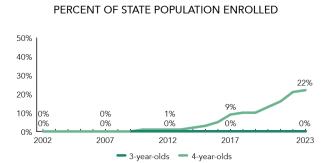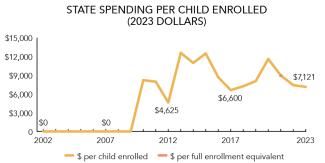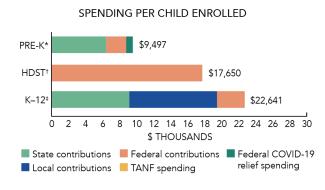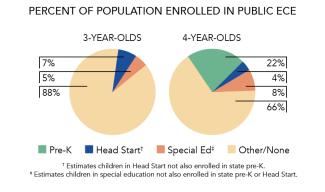
State of Preschool
Rhode Island
Access Rankings
Resource Rankings
Total Benchmarks Met
Overview

During the 2022-2023 school year, Rhode Island preschool enrolled 2,364 children, the same as in 2021-2022. State spending totaled $14,990,487, and an additional $1,844,456 in federal recovery funds supported the program, down $670,471 (4%), adjusted for inflation, since last year. State spending per child (including federal recovery funds) equaled $7,121 in 2022-2023, down $284 from 2021-2022, adjusted for inflation. Rhode Island met 10 of 10 quality standards benchmarks.
What's New

The state increased funding for the Rhode Island State Pre-Kindergarten Program (RI Pre-K) by $8.2M in the FY24 budget to ensure the federal funding that ended was backfilled and to allow for expansion pipeline work to add classrooms in the 2024-2025 school year. The Governor has a goal to reach 5,000 seats by FY28. Rhode Island remains committed to the high-quality programming that the model was built on and is being thoughtful on expansion, developing relationships and coaching models with programs interested in applying for RI Pre-K in the next application cycle.
The Rhode Island Executive Office of Health & Human Services received a $4 million Preschool Development Grant Birth through Five (PDG B–5) planning grant in December of 2022 for supports for early educators, including: an early educator supplemental compensation pilot program and higher education articulation support to advance degree attainment; focused strategic planning on early childhood multilingual learner supports and best practices; early childhood mental health; an infant/toddler system; early childhood development supports; early educator compensation; and RI’s quality rating and improvement system and family engagement and outreach, including for the RI Pre-K lottery in spring 2023.
Background
The Rhode Island State Pre-Kindergarten Program, launched in 2009, is provided in public schools, Head Start programs, and private childcare. All children who turn four years old by September 1 and are living in participating communities are eligible for the program, even though enrollment is also determined by lottery.
The Rhode Island Department of Education oversees the pre-K program, funded through an Early Childhood Categorical line, created in 2010, within RIDE’s state-budget. Using a phased-in approach, $10 million was invested over ten years to expand access to high-quality pre-K, commencing with communities containing a high proportion of children eligible for free or reduced-price lunch.
In 2014, Rhode Island received a $19 million federal Preschool Development Grant (PDG) to expand access to its high-quality pre-K program. This funding was used to expand access in high-need communities and to enhance program monitoring, evaluation, and technical assistance. Enrollment nearly doubled between the 2015-2016 and 2016-2017 school years as a result of the PDG support; the support did, however, level off, as planned, in 2017- 2018 and 2018-2019.
Teachers in the program must hold a bachelor’s degree in early childhood. The Rhode Island Department of Elementary and Secondary Education provides training and technical assistance through a vendor to all staff on an ongoing basis. The Rhode Island Pre-Kindergarten Program has been assessed for both process quality and program impact/child outcomes, including classroom quality and child outcomes in literacy, arithmetic, and social-emotional development.
Rhode Island State Pre-Kindergarten Program
Access
Resources
| Total state pre-K spending | $16,834,943 |
| Local match required? | No |
| State Head Start spending | $1,190,000 |
| State spending per child enrolled | $7,121 |
| All reported spending per child enrolled* | $9,497 |

*Pre-K programs may receive additional funds from federal or local sources that are not included in this figure. †Head Start per-child spending includes funding only for 3- and 4-year-olds. ‡K–12 expenditures include capital spending as well as current operating expenditures.
Rhode Island Quality Standards Checklist
| Policy | Requirement | Benchmark | Meets Benchmark? |
|---|---|---|---|
For more information about the benchmarks, see the Executive Summary and the Roadmap to State pages. | 10benchmarks met | ||
| Early Learning & Development Standards Benchmark | Comprehensive, aligned, supported, culturally sensitive | Comprehensive, aligned, supported, culturally sensitive | |
| Curriculum Supports Benchmark | Approval process & supports | Approval process & supports | |
| Teacher Degree Benchmark | BA | BA | |
| Teacher Specialized Training Benchmark | ECE | Specializing in pre-K | |
| Assistant Teacher Degree Benchmark | High School Diploma plus 12 college credits in ECE/CD or a CDA | CDA or equivalent | |
| Staff Professional Development Benchmark | 20 hours/year; PD plans; Coaching | For teachers & assistants: At least 15 hours/year; individual PD plans; coaching | |
| Maximum Class Size Benchmark | 20 (4-year-olds) | 20 or lower | |
| Staff to Child Ratio Benchmark | 1:10 (4-year-olds) | 1:10 or better | |
| Screening & Referral Benchmark | Vision, hearing, health & more | Vision, hearing & health screenings; & referral | |
| Continuous Quality Improvement System Benchmark | Structured classroom observations; Data used for program improvement | Structured classroom observations; data used for program improvement | |
